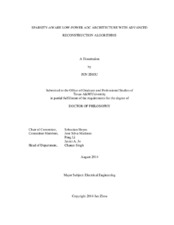| dc.description.abstract | Compressive sensing (CS) technique enables a universal sub-Nyquist sampling of sparse and compressible signals, while still guaranteeing the reliable signal recovery. Its potential lies in the reduced analog-to-digital conversion rate in sampling broadband and/or multi-channel sparse signals, where conventional Nyquist-rate sampling are either technology impossible or extremely hardware costly.
Nevertheless, there are many challenges in the CS hardware design. In coherent sampling, state-of-the-art mixed-signal CS front-ends, such as random demodulator and modulated wideband converter, suffer from high power and nonlinear hardware. In signal recovery, state-of-the-art CS reconstruction methods have tractable computational complexity and probabilistically guaranteed performance. However, they are still high cost (basis pursuit) or noise sensitive (matching pursuit).
In this dissertation, we propose an asynchronous compressive sensing (ACS) front-end and advanced signal reconstruction algorithms to address these challenges. The ACS front-end consists of a continuous-time ternary encoding (CT-TE) scheme which converts signal amplitude variations into high-rate ternary timing signal, and a digital random sampler (DRS) which captures the ternary timing signal at sub-Nyquist rate. The CT-TE employs asynchronous sampling mechanism for pulsed-like input and has signal-dependent conversion rate. The DRS has low power, ease of massive integration, and excellent linearity in comparison to state-of-the-art mixed-signal CS front-ends.
We propose two reconstruction algorithms. One is group-based total variation, which exploits piecewise-constant characteristics and achieves better mean squared error and faster convergence rate than the conventional TV scheme with moderate noise. The second algorithm is split-projection least squares (SPLS), which relies on a series of low-complexity and independent l2-norm problems with the prior on ternary-valued signal. The SPLS scheme has good noise robustness, low-cost signal reconstruction and facilitates a parallel hardware for real-time signal recovery.
In application study, we propose multi-channel filter banks ACS front-end for the interference-robust radar. The proposed receiver performs reliable target detection with nearly 8-fold data compression than Nyquist-rate sampling in the presence of -50dBm wireless interference. We also propose an asynchronous compressed beamformer (ACB) for low-power portable diagnostic ultrasound. The proposed ACB achieves 9-fold data volume compression and only 4.4% contrast-to-noise ratio loss on the imaging results when compared with the Nyquist-rate ADCs. | en |


